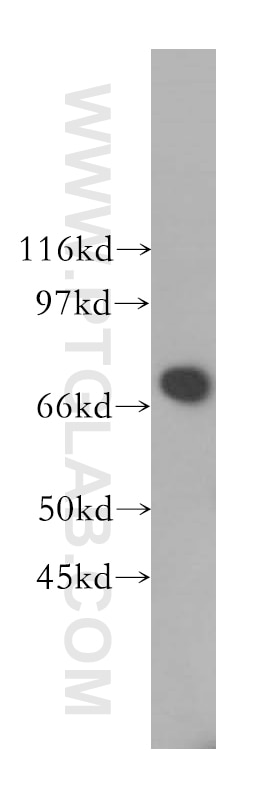Validation Data Gallery
Filter:
Tested Applications
| Positive WB detected in | COLO 320 cells, A375 cells |
Recommended dilution
| Application | Dilution |
|---|---|
| Western Blot (WB) | WB : 1:500-1:2000 |
| It is recommended that this reagent should be titrated in each testing system to obtain optimal results. | |
| Sample-dependent, Check data in validation data gallery. | |
Published Applications
| KD/KO | See 1 publications below |
| WB | See 4 publications below |
| IHC | See 1 publications below |
| IF | See 1 publications below |
| IP | See 1 publications below |
Product Information
13396-1-AP targets B4GALNT1 in WB, IHC, IF, IP, ELISA applications and shows reactivity with human samples.
| Tested Reactivity | human |
| Cited Reactivity | human, rat |
| Host / Isotype | Rabbit / IgG |
| Class | Polyclonal |
| Type | Antibody |
| Immunogen | B4GALNT1 fusion protein Ag4065 相同性解析による交差性が予測される生物種 |
| Full Name | beta-1,4-N-acetyl-galactosaminyl transferase 1 |
| Calculated molecular weight | 532 aa, 58 kDa |
| Observed molecular weight | 67.5 kDa |
| GenBank accession number | BC029828 |
| Gene Symbol | B4GALNT1 |
| Gene ID (NCBI) | 2583 |
| RRID | AB_2061077 |
| Conjugate | Unconjugated |
| Form | Liquid |
| Purification Method | Antigen affinity purification |
| UNIPROT ID | Q00973 |
| Storage Buffer | PBS with 0.02% sodium azide and 50% glycerol , pH 7.3 |
| Storage Conditions | Store at -20°C. Stable for one year after shipment. Aliquoting is unnecessary for -20oC storage. |
Protocols
| Product Specific Protocols | |
|---|---|
| WB protocol for B4GALNT1 antibody 13396-1-AP | Download protocol |
| Standard Protocols | |
|---|---|
| Click here to view our Standard Protocols |
Publications
| Species | Application | Title |
|---|---|---|
Front Genet Identification of a Novel Glycosyltransferase Prognostic Signature in Hepatocellular Carcinoma Based on LASSO Algorithm. | ||
J Gene Med B4GALNT1 promotes carcinogenesis by regulating epithelial-mesenchymal transition in hepatocellular carcinoma based on pan-cancer analysis
| ||
J Clin Lab Anal B4GALNT1 Regulates Hepatocellular Carcinoma Cell Proliferation and Apoptosis via the PI3K-AKT-mTOR Pathway |

